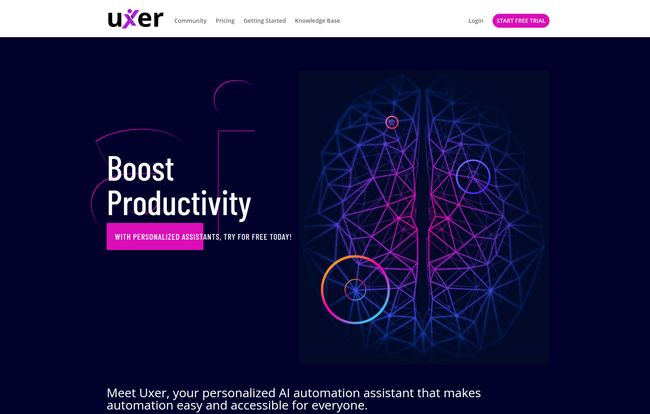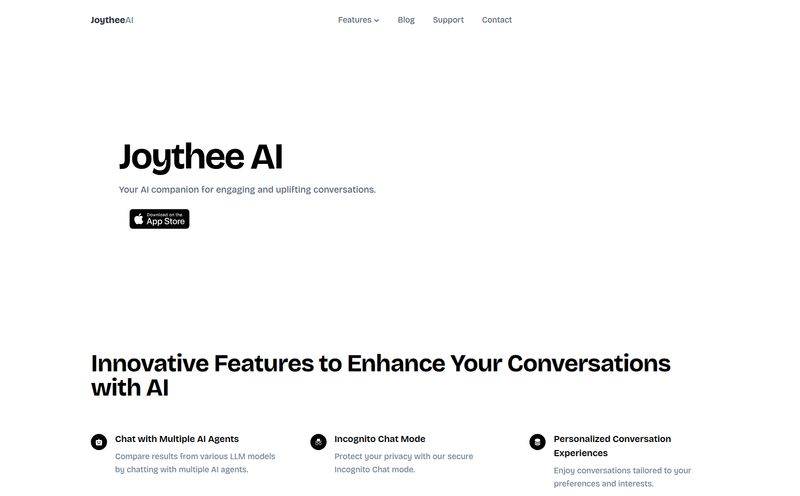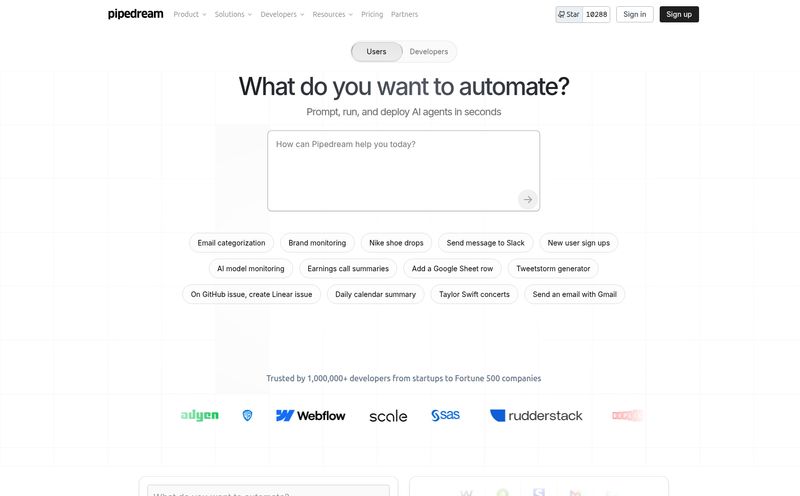Alright, let’s have a little chat. If you’ve spent any time in the trenches of digital marketing, QA testing, or operations, you know the automation promise. It's a beautiful dream of streamlined workflows, of tedious tasks just… happening. But then there's the reality. The reality can be a pain. A real, grind-your-gears, want-to-throw-your-monitor-out-the-window kind of pain.
We've all been there, meticulously crafting a test script or an RPA bot, only to have a developer push a minor UI update that moves a button two pixels to the left, shattering our beautiful creation into a million digital pieces. The culprit? Usually, it's brittle, unforgiving selectors. For years, this has been the necessary evil of automation. Well, I’ve been playing around with a tool called U-xer, and it’s making me think we might finally be able to leave that particular headache behind.
What Exactly Is U-xer Anyway?
So, what is this thing? At its heart, U-xer is an AI-powered automation assistant. I know, I know—slap “AI-powered” on anything these days and its value supposedly skyrockets. But stick with me here, because in this case, it’s not just marketing fluff. Instead of telling a bot to 'find element with ID=submit_button_v2' and praying that ID never changes, you interact with U-xer in a more… human way.

Visit U-xer
It’s designed to handle everything from Robotic Process Automation (RPA) to complex test automation, and even creating bots for things like 3D games. It works across pretty much any platform you care about: Windows, Mac, your browser, iOS, and Android. It’s less like a rigid script and more like teaching a very smart, very fast apprentice. You show it what to do, and its computer vision and AI figure out the context, not just the code coordinates. It’s a pretty big shift in thinking.
The Magic Behind the Curtain: Standout U-xer Features
Okay, let's get into the nitty-gritty. What makes this tool tick? A few features really stood out to me during my testing.
Finally, Selector-Free Automation That Works
This is the big one for me. The absolute headline act. U-xer uses what it calls “Selector-Free Visual Automation.” This means it doesn't rely on the underlying code structure of a webpage or application (the selectors) to find elements. Instead, it uses computer vision to see the screen like you do. It looks for a “Login” button, not `div class="btn primary-login"`. Why does this matter? Because when your design team decides the login button should be a different color and shape, U-xer doesn’t panic. It can still find the button. This makes your automations incredibly resilient to the kind of routine UI changes that break traditional scripts. It’s a game-changer, full stop.
Speaking Its Language with NLP
The next piece of the puzzle is its use of Natural Language Processing (NLP). You can literally write commands in plain English. Instead of some cryptic line of code, you can write a step that says “Click the button with the text ‘Add to Cart’”. This is massive. It dramatically lowers the barrier to entry. Your marketing manager, who knows the customer journey inside and out but doesn't code, can now build a bot to test the checkout flow. It democratizes automation, taking it out of the exclusive hands of developers.
One Script to Rule Them All (Almost)
One of the biggest time-sinks in automation is dealing with different platforms. The script you wrote for your website won't work on your Android app, which won't work on your iOS app. You end up tripling your workload. U-xer attacks this with reusable scripts. The logic you build for one platform can often be run on another with minimal (if any) changes. The idea of building a workflow once and deploying it across web, desktop, and mobile is the kind of efficiency I dream about. For real.
Who Is This Really For? The Coder and The Clicker
I was initially worried U-xer might be one of those tools that's too simple for developers and too complex for business users. But it seems to walk that tightrope surprisingly well. For the non-technical folks—the “clickers”—the visual interface and NLP are a godsend. You can build powerful workflows without ever looking at a line of code.
But for my fellow techies, they haven't left us out in the cold. There's a Code Editor Mode, Command Line integration, and a robust API. You can get under the hood, write custom logic, and integrate U-xer into your existing CI/CD pipelines. It’s a tool that can grow with you and your team's skills.
Let's Talk Money: U-xer Pricing Breakdown
Ah, the question everyone wants an answer to. What's the damage? I’ve seen tools like this hide their pricing behind a “Contact Us” wall, which is a personal pet peeve. I was happy to see U-xer has laid it all out. They seem to have updated this recently, which is a great sign of transparency.
Here’s a quick look at their plans (as of this writing):
- Basic: Starts at $89 per month. This gets you 30 scenarios, 1000 steps, and one “Agent” (think of an agent as a bot runner).
- Pro: Jumps to $179 per month. You get way more here—200 scenarios, unlimited steps, and 3 agents. This feels like the sweet spot for small to medium teams.
- Pro Plus: At $399 per month, this is for the power users. 500 scenarios and 5 agents.
- Custom: For enterprise needs, they offer custom plans with features like on-premise deployment.
The best part? All plans come with unlimited users and a 15-day free trial with no credit card required. That’s confidence. They're basically daring you to try it and not fall in love.
My Honest Take: The Good and The Not-So-Good
No tool is perfect, right? After kicking the tires, here's my unfiltered opinion.
What I love is obvious: the visual-first, selector-free approach is brilliant. The cross-platform reusability is a massive time-saver, and the NLP makes it so accessible. And including unlimited users on every plan? That’s a huge win for collaborative teams who don't want to get nickel-and-dimed on seats.
On the flip side, don’t expect to be a master in an afternoon. While creating a simple “log in and check my dashboard” bot is easy, leveraging its full power will require a bit of a learning curve. That’s not really a knock against U-xer, its a reality of any powerful platform. Also, while the pricing is transparent, it isn't dirt cheap. For a solo freelancer, the Basic plan might be a stretch. This tool is clearly priced for professionals and businesses who can see a clear return on investment through time saved and errors caught.
My Final Verdict on U-xer
So, is U-xer the automation assistant we've been waiting for? I think it’s a massive step in the right direction. It successfully bridges the gap between overly simple macro recorders and hyper-complex, code-heavy frameworks like Selenium or Playwright. It feels like the right tool for the modern era of agile development and diverse platforms.
If you're a QA lead tired of maintaining flaky tests, an operations manager looking to automate cross-application workflows, or a marketing team wanting to build sophisticated bots without hiring a developer, you need to check this out. Seriously, grab the free trial. You’ve got nothing to lose and a whole lot of tedious work to potentially eliminate forever.
Frequently Asked Questions about U-xer
Can U-xer really automate tasks inside a 3D game?
Yes, according to their documentation. Because it uses computer vision to recognize objects and elements on the screen rather than relying on standard UI code, it can interact with environments like 3D games and other non-standard applications. This is a pretty unique capability.
Do I need to know how to code to use U-xer?
For most tasks, no. The natural language commands and visual interface are designed specifically for non-technical users. However, if you want to perform highly complex logic or integrate with other systems via API, having some development knowledge will allow you to use its more advanced features.
Is U-xer cloud-based or can I host it myself?
The standard plans (Basic, Pro, Pro Plus) are cloud-based. However, they offer a Custom/Enterprise plan that provides an on-premise option for organizations with specific security or data governance requirements.
How does U-xer handle it when my app's UI changes?
This is its core strength. Since it visually identifies elements (like a button's appearance or text label) instead of relying on code-based selectors, it's much more resilient to UI changes. As long as an element is still visually recognizable to a human, U-xer has a high chance of finding it without any script updates.
What's the deal with "Unlimited Users" on all plans?
It's exactly what it sounds like. All of their paid plans allow you to invite as many team members as you want to your account to collaborate on building and managing automations. You're billed based on usage (agents and scenarios), not by the number of user seats.
Reference and Sources
- U-xer Official Website & Pricing: u-xer.ai
- Further Reading on RPA: IBM - What is Robotic Process Automation?



